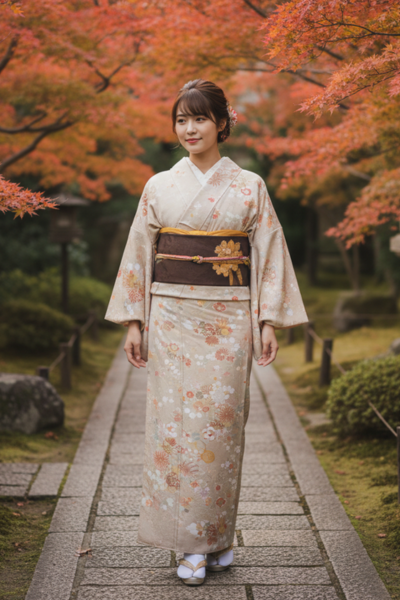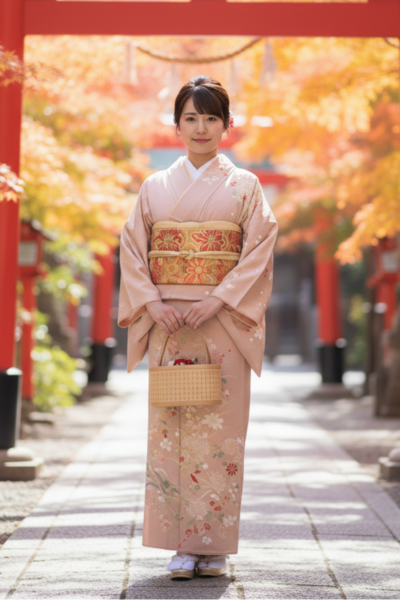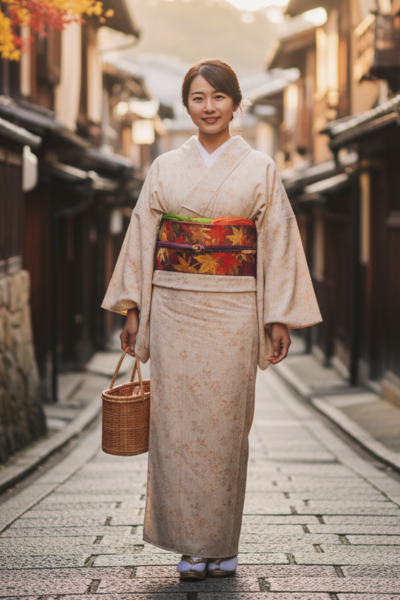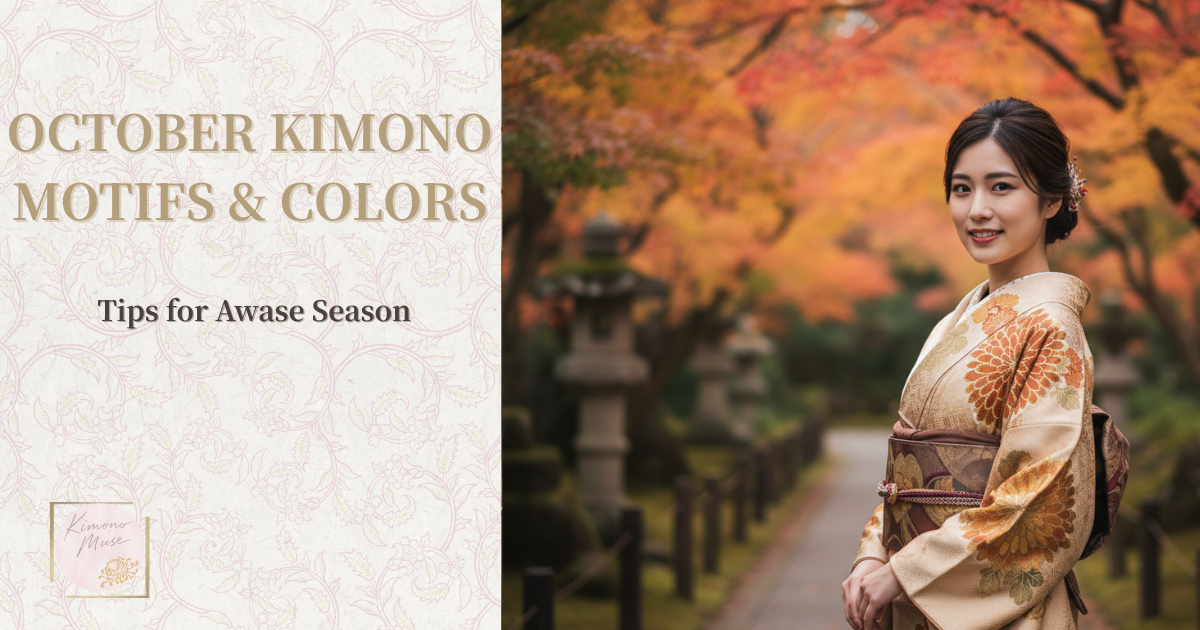October marks the seasonal shift in kimono: from hitoe (unlined kimono) to awase (lined kimono).
Because awase has a double layer of fabric, it carries a sense of weight and creates a more composed silhouette. It is the most appropriate style for this time of year, when the leaves begin to turn and autumn deepens.
However, in recent years temperatures have often remained high, and it is not unusual to have warm days in October. In such cases, there is no problem choosing a hitoe instead.
That said, for formal occasions in the latter half of October, wearing awase is considered the standard etiquette.
In this article, we will introduce color palettes and recommended motifs for October kimono coordination, along with this month’s featured motif: the chrysanthemum (kiku).
Recommended Colors
For October kimonos, deep and subdued colors are especially fitting.
Shades such as beige, brown, enji (deep crimson), and kuchiba-iro (withered-leaf brown) are popular, as they reflect the natural tones of autumn.
When you choose a calm, muted color for your kimono, it is recommended to add brightness through the obi and accessories.
For example, pairing it with a pale gold or silver obi, or using a lighter-colored obiage (obi scarf), will create a more balanced and elegant coordination.
On warmer days, when hitoe (unlined) kimono may still be comfortable, you can combine it with an awase (lined) obi to give your outfit the appearance of autumn, even if the fabric is lighter.

A calm and refined style featuring motifs of chrysanthemums and autumn plants, perfect for strolling through a garden of autumn leaves.

A soft pink tsukesage paired with an elegant fukuro obi. An ideal choice for Shichi-Go-San celebrations or autumn shrine visits.

A rustic tsumugi kimono combined with an obi patterned with autumn maples, perfect for enjoying a casual stroll through traditional townscapes.
Recommended Motifs for October
As autumn deepens in October, kimono designs often feature motifs inspired by plants and elements of nature.
| Motif | Meaning / Symbolism | Expression in Kimono |
|---|---|---|
 Kiku (Chrysanthemum) Kiku (Chrysanthemum) | A symbol of longevity and nobility. Believed to ward off evil, it represents autumn. | Can be used alone or combined with other motifs such as karakusa (arabesque) or flowing water. Found widely, from highly formal garments to casual komon. |
 Momiji (Maple leaves) Momiji (Maple leaves) | A symbol of autumn. The changing colors of the leaves express the passage of the seasons. | Frequently depicted on komon or obi, immediately evoking the feeling of autumn. |
 Ichō (Ginkgo) Ichō (Ginkgo) | The golden leaves symbolize prosperity and longevity. | Simple forms are stylized and often used in small accessories and obi patterns. |
 Fukiyose (Scattered autumn plants) Fukiyose (Scattered autumn plants) | A design showing leaves, flowers, and nuts blown together by the autumn wind. | Combines various seasonal plants in a lively, decorative expression. |
 Tatsutagawa (Tatsuta River) Tatsutagawa (Tatsuta River) | A classic autumn scene showing maple leaves floating on flowing water. | Suitable for formal attire such as tomesode and hōmongi. |
 Kuri no mi (Chestnuts) Kuri no mi (Chestnuts) | Represents the fruits of autumn and symbolizes abundance. | Often found in obi and komon, creating a friendly, familiar atmosphere. |
 Ine (Rice plant) Ine (Rice plant) | Symbolizes the autumn harvest. Deeply tied to rice cultivation culture, stylized as rice ears or sheaves. | Used as auspicious motifs celebrating harvests, also adopted in komon. |
 Shika (Deer) Shika (Deer) | A symbol of longevity and marital harmony. Deer are considered sacred messengers of the gods in Japan. | Often paired with autumn plants or maple leaves, expressing seasonal sentiments. |
 Kari (Wild geese) Kari (Wild geese) | Migratory birds that symbolize autumn. Their formation in flight is often depicted. | A traditional seasonal motif, popular in both formal and casual kimono designs. |
Designs that depict autumn scenery, such as fukiyose (scattered autumn plants) or Tatsutagawa (maple leaves floating on the Tatsuta River), strongly express the season and also convey a playful spirit.
Featured Motif: Kiku (Chrysanthemum)
The chrysanthemum has long been cherished as a symbol of longevity and nobility, and it is one of the most representative floral motifs for October.
There are many variations, such as kikka-mon (patterns depicting chrysanthemum blossoms), kiku-karakusa (chrysanthemum combined with arabesque), and kikusui (chrysanthemums floating on flowing water).
For coordination, pairing chrysanthemum motifs with deep enji (crimson) or purple kimono creates an elegant, noble impression.
When set against calm base colors like beige or brown, the chrysanthemums give a more understated, autumnal look.
Adding a bright obi can enhance the flower’s brilliance, making the style suitable even for formal occasions.
| Motif | Meaning / Symbolism | Expression in Kimono |
|---|---|---|
 Rangiku (乱菊 – Wild Chrysanthemum) Rangiku (乱菊 – Wild Chrysanthemum) | Depicts chrysanthemums blooming with long, disheveled petals. Gorgeous and dynamic in appearance. | Used in hōmongi (semi-formal kimono) and komon (casual small-pattern kimono), giving a bold and luxurious impression. |
 Mujina-giku (むじな菊 – Fine Chrysanthemum) Mujina-giku (むじな菊 – Fine Chrysanthemum) | Petals drawn densely and finely, resembling the fur of a mujina (badger). A very delicate design. | Commonly seen in Edo-period komon and yukata, creating a calm and subtle atmosphere. |
 Kiku no maru (菊の丸 – Circular Chrysanthemum) Kiku no maru (菊の丸 – Circular Chrysanthemum) | A stylized chrysanthemum in a circular form. Considered an auspicious motif. | Can be used alone or combined with other round motifs such as pine, bamboo, plum, or cherry blossoms. |
 Kikusui (菊水 – Chrysanthemums on Flowing Water) Kikusui (菊水 – Chrysanthemums on Flowing Water) | Shows chrysanthemums floating on a stream. A celebratory motif symbolizing longevity. | Appears in family crests and is often used in highly formal settings. |
 Manjū-giku (万寿菊 – Manjū Chrysanthemum) Manjū-giku (万寿菊 – Manjū Chrysanthemum) | A simplified, round chrysanthemum design. Named for its resemblance to manjū (a round sweet bun). | A motif celebrating longevity, popular since the Edo period. Also known as Kōrin-giku (after the artist Ogata Kōrin). |
Summary
October marks the transition from hitoe (unlined kimono) to awase (lined kimono).
For outfits that reflect the deepening of autumn, subdued colors and seasonal motifs are especially effective. Designs inspired by nature—such as momiji (maple leaves), ichō (ginkgo), fukiyose (scattered autumn plants), and Tatsutagawa (maple leaves floating on the Tatsuta River)—are widely used. Motifs of harvest, such as ine (rice plants) and nuts, as well as animals like deer and wild geese, also add an autumnal touch.
Among them, the chrysanthemum (kiku) stands out as the representative floral motif of October, symbolizing longevity and nobility. With its many variations, it brings elegance and brilliance to kimono designs.
By flexibly choosing between hitoe and awase according to the weather, and by incorporating seasonal colors and motifs, your kimono coordination in October will gain richness and depth.
✿Column: Fumi’s Kimono Diary ✿
The other day, I finally brought out my awase (lined) kimono.
Mornings and evenings have turned cool, yet the afternoons are still warm, leaving me a little uncertain about what to wear.
Even so, when I tie on an obi with a chrysanthemum motif, it instantly puts me in an autumn frame of mind.
In the world of kimono, it is considered stylish to dress “a little ahead of the season.”
The maples have not yet turned red, but by pairing my outfit with small accessories featuring ginkgo or fukiyose (scattered autumn plants), I feel as though I’m walking just a step ahead into the coming season.


